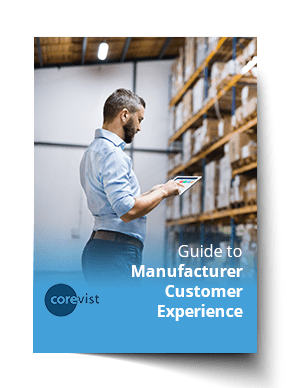Share
Author
George Anderson
Share
Originally published Sep 24, 2019. Refreshed Oct 20, 2021.
Customer experience hasn’t always been top-of-mind for manufacturers. Phone, fax and email were always adequate for order entry and post-order inquiries. All that changed in the wake of the pandemic and the accelerated shift to digital.
Now manufacturers are scrambling to create a better customer experience through self-service digital options. But the shift is challenging for some organizations, as it’s not simply a technological change. It requires cultural change and a new mindset as well.
Here are 5 keys to transforming customer experience for manufacturers.
1. Innovate in an agile way
Digital transformation is all about being agile. Not only Agile methodology for software rollouts, but a larger philosophy of agileness for the organization as a whole. That means your B2B portal must facilitate an agile approach to customer relationships.
So how can you make your B2B portal agile?
- Don’t hold your success hostage to waterfall methods. Look for a partner who will test the working web channel with your real customers, take their feedback, and incorporate it into Phase I of your solution—so you get value immediately. (Hint: This is the Corevist methodology. Check out this post for more: The Power Of Customer Collaboration In B2B eCommerce.)
- Choose a solution with seamless, global scalability for bringing new territories and brands online. This is best facilitated by a templatized ERP integration that allows for fast rollout of numerous web portals.
2. Predict new opportunities
A B2B portal with online ordering (i.e. B2B eCommerce) offers all kinds of opportunities to collect data on what your customers want. You can use that data to inform future product cycles, research and development, sales and marketing strategies, and more. A good B2B eCommerce solution should offer you rich analytics — things like:
- Average order value
- Revenue growth
- B2B eCommerce conversion rate
- Abandonment rate
- Total transactions
- Highest-value products
- Average session duration
- % of new users
- And much more
Of course, having these analytics on hand isn’t enough. You need to leverage them, which means reviewing them regularly, understanding what they mean, and applying these insights to future iterations.
3. Increase transparency and trust
When it comes to online ordering, the stakes are high. If your B2B customers can’t complete their transactions online (or if they encounter fear, uncertainty, and doubt when trying to do so), then your eCommerce experience isn’t increasing transparency and trust — it’s reducing both.
In the age of high digital expectations, that’s a recipe for disaster.
So what does it take to increase transparency and trust through your B2B eCommerce portal? Here’s what your customers are looking for:
- Accurate, personalized pricing. If the web portal doesn’t show them the same pricing they would get over the phone, then it’s not building trust. If the web portal isn’t trustworthy, customers will abandon it and go back to phone/fax/email ordering.
- Accurate, personalized ATP/inventory data. If you use ATP calculations to determine the available product quantity that each customer sees, then your web portal needs to display the quantity associated with the logged-in user. A lack of accurate inventory availability won’t build customer trust in your B2B eCommerce channel.
- Order status, shipment status, and account status. If your B2B portal is going to serve your customers’ needs, it should serve all their needs related to doing business with you. That means online ordering isn’t enough. You also need to show them 100% accurate order history straight from the ERP, regardless of ordering channel — and you need to show real-time carrier shipment updates, too. You also need to display the customer’s account status, open invoices, and real-time credit limit. It’s also a good idea to offer invoice payments so your customers can keep their accounts in good standing.
4. Offer personalized experiences
We’ve already mentioned two areas in which your B2B eCommerce solution must offer personalization — pricing and ATP or inventory availability. But an intelligent B2B portal offers other opportunities to personalize your customer experience, too:
- Personalized catalogs of ancillary products/consumables that go with a customer’s major products. Chances are, you have these product relationships specified already in your ERP system. With a real-time, direct integration, your B2B portal can display those relationships, making it easy for customers to buy everything they need to accompany their major products.
- Personalized upsell/cross-sell driven by product relationships in the ERP system. This allows you to leverage existing ERP data and increase the value of the B2B eCommerce site for every customer.
- Personalized on-behalf-of privileges for users who buy on behalf of multiple customers. These relationships are already mapped in the ERP system, so your B2B portal solution should leverage those relationships for logged-in users.
5. Always be on, in real time
At first, it might seem silly to offer this advice for your B2B portal or eCommerce store. That’s the whole idea, right? eCommerce is always on.
Actually, it’s not that simple. Being “on” means more than just having a B2B eCommerce site that loads 24x7x365. Being “on” means that the web portal can serve ALL customer needs 24x7x365.
The key to this is real-time ERP integration. Almost every point we’ve covered above depends on displaying real-time ERP data in the web store. If your solution displays this purchase-critical data, then you can safely say you’re always “on,” in real time.
The takeaway
The pressures of the digital age are intense, but the key is to find the signal in the noise. What’s absolutely essential for your new customer experience in a B2B portal? In many cases, it’s real-time ERP data and logic that makes the portal usable or unusable. Focus on the functionality your customers need most and involve them in the process of finding a solution.
NEW Resource:
Ultimate Guide to Manufacturer Customer Experience
Use these 5 keys to create a competitive customer experience in the digital age.










